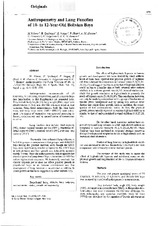Anthropometry and lung function of 10- to 12-year-old Bolivian boys

View/
Date
1994Author
Villena, M
Spielvogel, H
Vargas, E
Obert, P
Alarcón, AM
Gonzales, C
Falgairette, G
Kemper, HCG
Metadata
Show full item recordAbstract
Abstract.
Anthropometric measurements of 23 HAHSES, 44 HALSES, 43 LAHSES, and 28 LALSES boys (see Introduction to this Supplement) are presented here. They include body height (H), body weight (BW), upper arm circumference (UAC), and skinfold thickness taken at four locations. From these measurements, body fat, lean body mass, and body mass index (BMI = BW/H2) were calculated. The degree of maturation was assessed according to Tanner, orchidometry, and by quantification of testosterone in saliva. Lung function data include: vital capacity (VC), forced expired volume per 1 s (FEV1), functional residual capacity (FRC), residual volume (RV), and total lung capacity (TLC). The results show enhanced lung volumes in both HA groups in comparison to LA groups, with HALSES boys having the greatest increase, even though the LSES boys were significantly smaller compared to the HSES boys at both altitudes and their growth was delayed by approximately 2 years. From the anthropometric data it appears that physical growth of prepubertal boys is dependent on SES but not on high-altitude exposure. We tentatively conclude that chronic hypoxia per se does not affect physical growth in prepubertal boys in an Andean environment and that development of lung function is accelerated in relation to linear growth as has been suggested by other authors (15).
